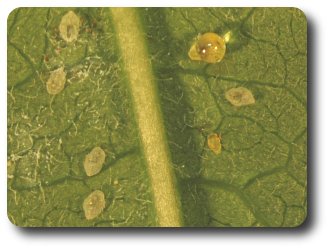The tradition of bringing poinsettias indoors during the holidays probably originated in Mexico where poinsettias are used to decorate the nacimiento or nativity. A wonderful legend holds that in the town of Cuernavaco a young girl had no flowers to decorate the nacimiento at her church and, instead, she brought to church a weed growing by the side of the road. An angel transformed the weed into the beautiful poinsettia and, ever since, poinsettias have been used a seasonal decoration. Poinsettias are as much of a holiday tradition as mistletoe, holly, and an evergreen tree in many homes.
You may find a colony of whiteflies like this on your holiday poinsettia.
For an entomologist one activity that adds some real adventure to choosing just the right poinsettia is finding one with a nice, light infestation of whiteflies. This is no easy task because greenhouses and nurseries take great care to keep these rascals off their poinsettias. Whiteflies are small sucking insects and relatives of more commonly known sap-suckers such as aphids. They are found on the underside of poinsettia leaves where the y insert tiny beaks into leaves to extract sap. Plant sap contains nutrients needed for their growth and development. If numerous, whiteflies turn leaves a sickly yellow. Large populations can deform leaves or cause leaves to drop prematurely. As whiteflies feed, they excrete a sugary waste product called honeydew. This sticky liquid can become a substrate for the growth of an ugly fungus known as sooty mold.
Adult whiteflies look like tiny moths.
Whiteflies have four stages in their lives, egg, nymph, pupa, and adult. An adult whitefly lays eggs on the undersurface of a leaf. After several days, eggs hatch and mobile nymphs, called crawlers, move about the leaf surface until they find a suitable place to feed. Nymphs hunker down, shed their skin, and become stationary for the remainder of their youth. After one more molt, a pupa forms, and from this pupa emerges the adult whitefly. Shed pupal skins often festoon the underside of poinsettia leaves. Adult whiteflies look like tiny white moths. They too have sucking mouthparts and eat the sap of poinsettias. If disturbed, they flutter from the leaf surface. The nymphs and pupae are usually yellowish or whitish and translucent. Red eyespots can be seen on the pupa shortly before the adult whitefly emerges.
The large droplet of honeydews sits atop a whitefly nymph.
For the folks that grow poinsettias, whiteflies can be a very serious problem. If populations become too great, entire crops are lost. The most common whiteflies that come home with poinsettias are the greenhouse whitefly, Trialeurodes vaporariorum, and the silverleaf whitefly depicted in these images. Recently, a new strain of silverleaf whitefly, the dastardly “Q biotype”, has been found in the United States. This strain is resistant to many of the pesticides formerly used to control whiteflies and is causing headaches for the greenhouse industry. Fortunately, entomologists are finding new ways to control whiteflies using tiny wasps that attack them, predatory beetles that eat them, and pathogens that give them lethal infections. This bug of the week may sound a bit like the Nightmare before Christmas but if you find a few whiteflies on your poinsettia try to relax and enjoy them. If whiteflies are numerous and your poinsettia looks whipped, you may do best to toss it out and replace it. The Maryland Home and Garden Information Center has a nice fact sheet on how to care for your poinsettia during the holidays and beyond. http://www.agnr.umd.edu/users/hgic/pubs/online/poinsettia_pfv.pdf
If you have an image that you would like to contribute, or a request, please send it to me at mraupp@umd.edu and I may be able to share its story in a future bug of the week.
References:
To learn more about whiteflies, please visit the web sites listed below.
http://www.agnr.umd.edu/ipmnet/qwhitefly.pdf
http://insects.tamu.edu/fieldguide/aimg97.html



